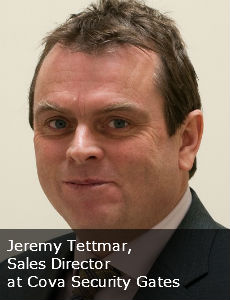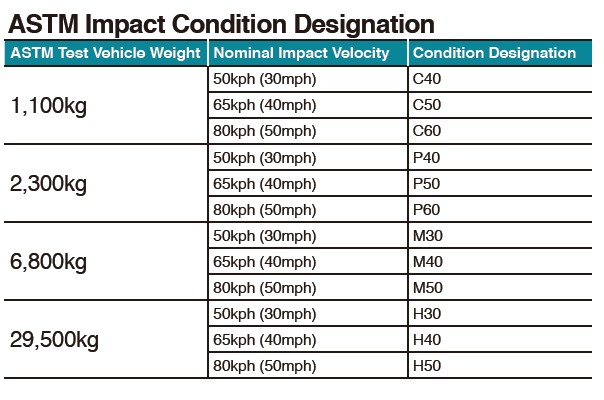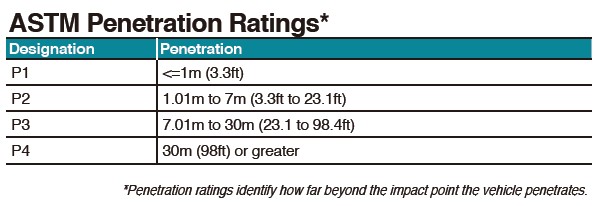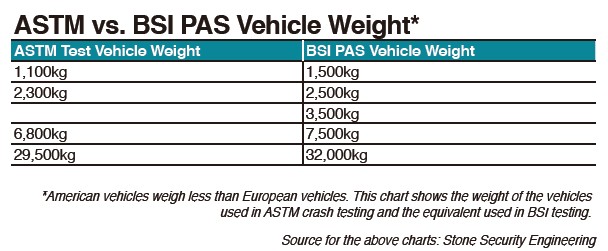Vehicle security barriers come in a variety of shapes, sizes, and strengths. Differentiating between them is the first step to choosing the right product.
The unrelenting presence of terrorism around the world has driven growth in the vehicle security barrier sector of the perimeter security market. Securing critical infrastructure and government entities with a first line of defense in the forms of barriers, blockers, and bollards help to mitigate the dangers of vehicle-borne attacks.
While previously more of an optional choice, vehicle safety barriers have become a necessity in the post-Sept. 11 world. Although vehicle-borne attacks are thankfully not frequent occurrences in most parts of the world, high-security areas are no longer leaving things up to chance, instead taking measures to ensure high levels of security for their perimeters.
TechnologyAdvancements in vehicle barrier technology have been borne out of need. One of these advancements is the development of shallow mount technology. According to Lucy Foster, Marketing Executive of ATG Access, the method of using a shallow foundation was originally designed to combat the problematic fitting of traditional bollards and barriers, which require deep foundations and can cause disruption to service networks and habitats. This technology requires a shallower foundation, but still meets the requirements of high security ratings. By allowing for a shallower foundation, Foster pointed out that the technology is also a "greener" solution. A shallower foundation means less disruption to the environment, as well as the need for less machinery on site, which in turn produces less pollution. Furthermore, the solution uses "less than 25 percent of the concrete employed in a traditional foundation," said Foster.
Another advancement is the development of surface-mount technology. With no need to build a foundation, this solution allows for high-security barriers, blockers, and bollards to be installed on a temporary or permanent basis, quickly and efficiently. In order to sidestep the process installing a base foundation, surface-mount equipment is simply affixed to the existing surface, making it an excellent solution for scenarios in which the environment is not conducive for products that require a foundation. The 2012 London Olympic Games is a good example of an event that deployed the use of surface-mounted vehicle barriers. With stadiums and arenas in need of high-security products, particularly at remote sites that only need high-security protection for a limited time, Foster noted that surface-mount technology perfectly fitted the Olympic Games requirements.
example of an event that deployed the use of surface-mounted vehicle barriers. With stadiums and arenas in need of high-security products, particularly at remote sites that only need high-security protection for a limited time, Foster noted that surface-mount technology perfectly fitted the Olympic Games requirements.
Employed by Cova Security Gates, fiber arresting technology for automated gates reduces the needfor large and heavy weight sections of steel. By reducing the weight of the project, it makes the gates much safer, as there is less critical mass, according to Jeremy Tettmar, Sales Director at Cova Security Gates. Tettmar added that the fiber arresting technology also makes controlling and stopping gates a lot easier, as well as reduces the risk of crushing and vehicle impact damage. Additionally, less weight increases the life of products and reduces maintenance, according to an industry source. Another more recent trend is the switch over to electric barriers, opposed to the traditional hydraulic barriers, as pointed out by Greg Hamm, VP of Sales at Delta Scientific. In the past, hydraulic barriers were the only ones that could provide the speed needed to lift such heavy metal barriers for a quick response to attack. However, as technology has advanced, electric barriers may offer a more cost-efficient, easier to install solution that requires less maintenance, while being able to provide the speed needed for hostile vehicle mitigation.
ones that could provide the speed needed to lift such heavy metal barriers for a quick response to attack. However, as technology has advanced, electric barriers may offer a more cost-efficient, easier to install solution that requires less maintenance, while being able to provide the speed needed for hostile vehicle mitigation.
Standards and Ratings
Independent testing organizations such as the American Standards for Testing and Materials (ASTM) in the U.S. and the British Standards Institute (BSI) in the U.K. have crash and installations standards for companies to help rate their perimeter security products. For high-security barrier installations, impact ratings are mandatory worldwide. These product ratings can give companies the competitive edge they need when tendering for jobs domestically and internationally. As the market becomes more regulated and superior products are becoming easier to find, said Foster, it is no longer enough for companies to simply pass an impact test — products will also be compared to other similar products.
While BSI standards and ASTM standards are similar, one of the main differences lies in the difference between American and European car dynamics. Tettmar pointed out that American trucks have hoods that absorb more impact than European trucks that lack hoods. It is also noted that European vehicles tend to be heavier than American vehicles.
British StandardsDesigned to assure organizations that vehicle security barriers will not only provide the level of impact resistance they require, but have also been tested to a uniform standard, the BSI created PAS 68:2010 and PAS 69:2006 for crash testing and installation, respectively, of hostile vehicle equipment.
The BSI website states PAS (Publicly Available Specification) 68 — Impact Test Specifications for Vehicle Security Barriers — refers to a classification system for the performance of vehicle security barriers and their supporting foundations when subjected to a single horizontal impact.
American Standards
Ratings in the U.S. are provided by the ASTM and the US Department of State (DoS); however, the DoS no longer oversees testing in the U.S., instead the US Army Corps of Engineers Protective Design Center under the US Department of Defense (DoD) has taken over this task. While the ASTM F2656 — Standard Test Method for Vehicle Crash Testing of Perimeter Barriers — has superseded the DoS SD-STD-02.01 Crash Test Certification, products can still be rated under both. Testing is conducted throughout the U.S. at certified independent labs. Once testing is completed, the results are verified by the corresponding standards entity and then certified.
While the general concept behind the DoS and ASTM standards are the same, there are differences. One of the main differences, is in the vehicle penetration ratings. After the 2003 update, the DoS SD-STD-02.01 eliminated all penetration levels except the 3 feet (1 meter) standard, which was the lowest level of penetration allowed. On the other hand, ASTM F2656 maintains a four-level penetration rating, with the lowest level of penetration — P1 — equivalent to the DoS penetration standard. Another difference lies in the types of vehicles used for testing. Hamm pointed out that the DoS test standard requires the use of pick-ups, medium-sized trucks, and trucks that haul heavy goods, whereas the ASTM defines four types of vehicles for testing: small passenger cars (C), pickup trucks (P), medium-duty trucks (M), and heavy goods trucks (H). It also established four categories of penetration.
For comparison, the DoS ratings of K4, K8, and K12 can be compared to ASTM ratings of M30-P1, M40-P1, and M50-P1, respectively. The DoS also has a higher rating of K54 which uses a truck weighing 30,000 kilograms traveling at 50 miles per hour.

 Others
Others Apart from standards institute ratings, there are also verifications from security organizations such as the Perimeter Security Suppliers Association (PSSA). According to the PSSA website, “the PSSA is the trade association for companies involved in the supply of equipment and services designed to provide the highest levels of physical protection for sites and their perimeters from terrorist or criminal attack that involves the use of extreme force or explosives.” Incorporated in the U.K. in 2009, the group has introduced a product verification scheme aimed at providing confidence to perimeter systems buyers and others that products supplied by its members conform to internationally recognized quality standards.